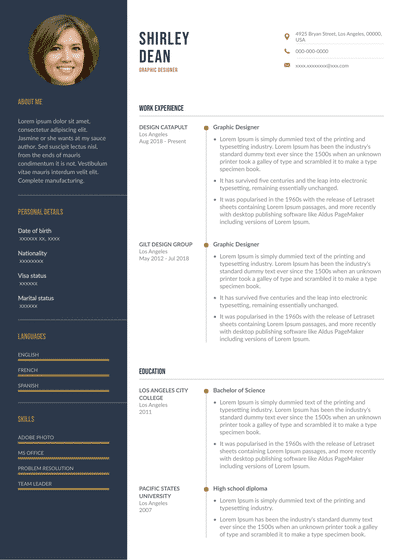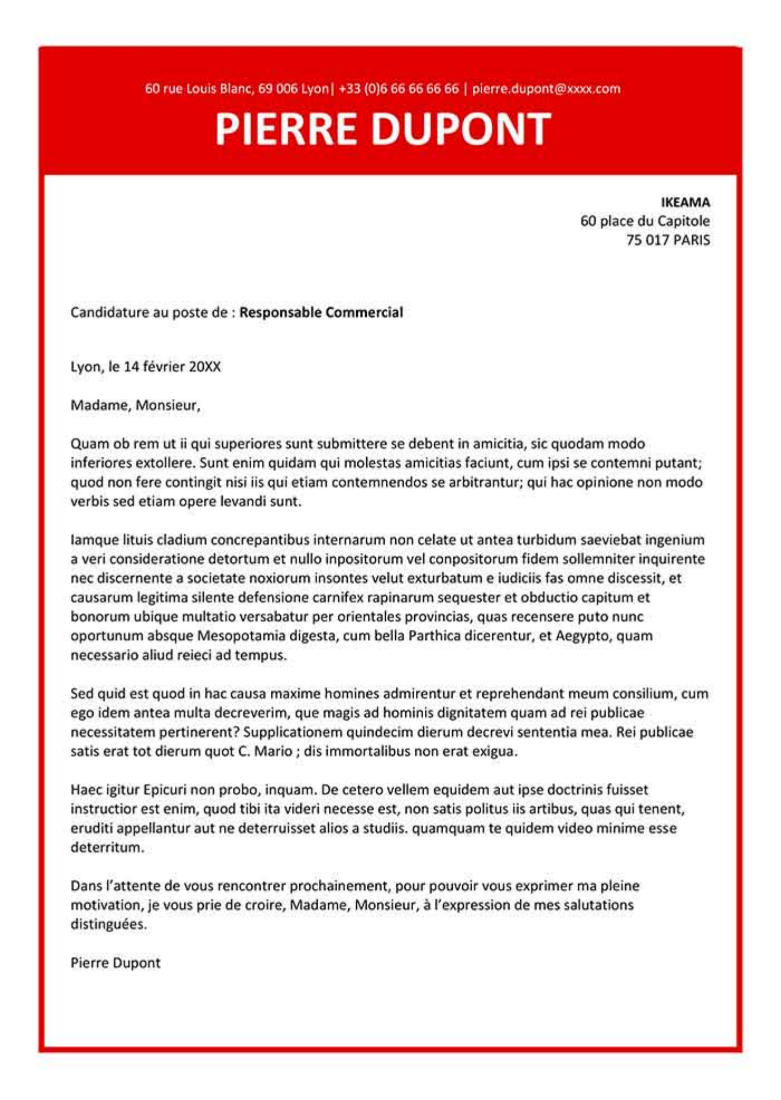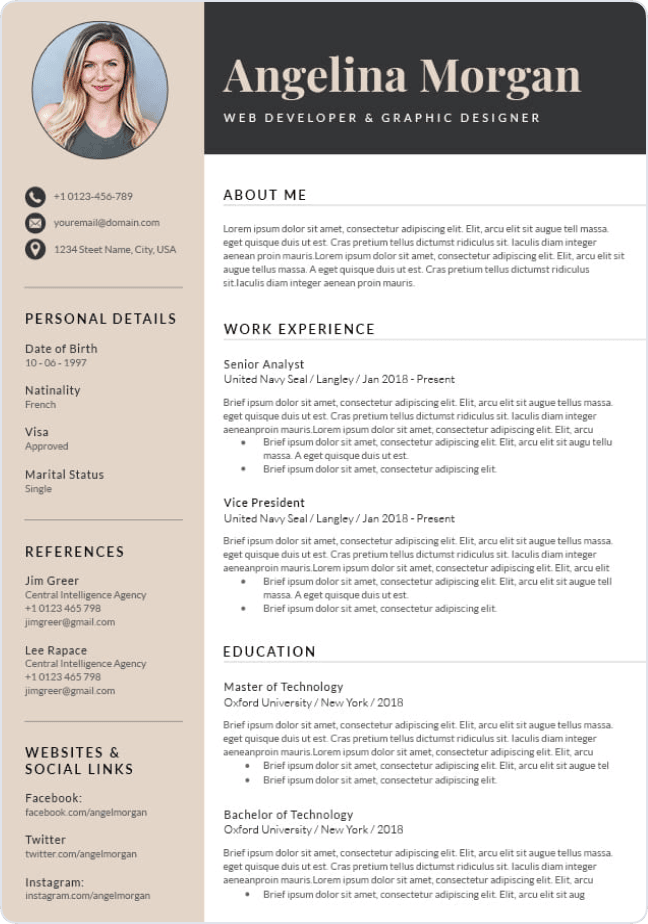Why can’t you just send your portfolio link and wait for the interview? We’ll discuss.
In this article, we’ll guide you through to write a perfect graphic designer resume that is better than most other resumes your hiring manager gets – a beautiful resume with the right information to 10x your chances of getting more interviews.
Further,
- A complete example of an experienced graphic designer resume.
- A complete example of a freelance graphic designer resume.
- How to choose the best graphic designer resume template, format, and layout.
- A step-by-step guide to writing each section of your resume.
If you’re looking for a quick and easy way to create your resume, check out our ready-to-fill resume templates to make your resume within 10 minutes. Try our resume builder for free – if you enjoy it, start sending out your application to potential jobs NOW.

Freelance Graphic Designer Resume Example
Frank Kelly
Senior Graphic Designer
frankkelly@gmail.com(246)726-8263
Professional Summary
A freelance graphic designer with over 3 years of experience working with clients in Real Estate, F&B, Healthcare, Technology, and Hospitality seeks to find a permanent position in a passionate team. One of my branding and logo design work from last year for a tech company won The Brand Impact Award for the year 2021.
Recent Freelance Experience
InMarc Real Estate - CA
2021-2022
InMarc is a real estate company based in California with an annual sale of $15M and a team of 12 real estate agents.
- Created social media posts and Facebook ad creatives for campaigns worth $15,000 per month.
- Managed the company's content calendar one month in advance.
CakeBucket - NYC
2021
CakeBucket is an artisan cafe with specialty drinks and cakes based in New York City currently growing to its 7th location.
- Did the photoshoots of store premises and food in the cafe.
- Edited photos on Adobe Photoshop and Lightroom.
- Created social media posts and ad creatives.
- Created web banners for the e-commerce website.
FitnessPal -UK
2020-2021
FitnessPal is a UK-based fitness mobile application targeting people who work from home.
- Carried out the brand revamp project for changing its marketing position.
- Had several meetings with the UK design and development team on the implementation.
- Developed new branding guidelines, branding message, color theme, and logo.
Education
Design Media Arts University
Bachelor’s degree in Graphic Design
2016-2019
Skills
- Logo design
- Branding
- Adobe creative cloud
- Product Photography
- Interpersonal skills
- Time management
- Creativity
- Web design
See these other resumes in different creative fields if you need further inspiration👇
How to Write a Graphic Designer Resume from Scratch?
Throw your old resume away and let’s start writing a perfect graphic design resume from scratch.
A new resume that could get you 7 interviews out of 10 jobs you’re applying for.
Why can’t we forget the resume altogether and send a link to our portfolio and get the job?
For today’s graphic design jobs, recruiters get thousands of resumes – most of them don’t even have the basic required experience wasting lots of time for the hiring manager.
Such recruiters now use a computerized system called Applicant Tracking System (ATS) – based on the recruiter’s instructions, the system shortlists the candidates with relevant experience and skills.
Therefore, sending a comprehensive resume with your experience and skills would be predominantly important for graphic designer jobs.
Not just any resume – but a resume that’s perfectly optimized keeping both ATS and the hiring manager in mind.
A resume with the right keywords to get through the ATS and the right structure and template to win the hiring manager.
Let’s start with defining the layout, format, and template for graphic designer resumes.
Graphic design resume layout
A resume layout is a plan that we draft at the beginning of the resume writing process. It consists of the main headings (sections), subheadings, and any other important sections that we should include in our resume.
The resume layout makes it easy to organize the information as well as the space on the resume.
We recommend the following layout for graphic designers:
- Header: name with contact information.
- Professional Summary/ Objective Summary.
- Work History.
- Education.
- Skills/ IT skills.
- Additional sections (certificates, languages, courses).
Graphic design resume format
It's important to determine your resume writing format at the beginning.
The format will define the order in which you write your experience. As a graphic designer, you may decide to write your recent experience first or the most relevant experience first – it all depends on your profile.
There’re three standard resume formats in use:
- Functional
- Reverse chronological
- Hybrid
Functional (skill-based) resume format:
In this format, you will write your key skills first and provide evidence in the form of experience. This is a great format to use for freelance graphic designers.
Reverse chronological resume format:
In this format, your most recent work experience, company, and position will be listed first. The rest will be listed in reverse chronological order.
We recommend this format for most graphic designers.
Hybrid resume format:
In this format, we use both the above formats in writing the experience section. If your experience consists of a full-time graphic designer position plus freelance experience, we suggest you use a hybrid/ combination format.
If you need to read more about different formats and examples before choosing one for your resume, refer to our complete guide to resume formats.

Perfect resume template for graphic designers
The resume template is in control of the overall look and feel of your resume. It will tremendously contribute to making the first impression about your application.
Pick the right resume template that matches your profile. A graphic designer resume should demonstrate your overall design skills. How you select the fonts – colors – and the rest of the design features will be a working example of your expertise.
In our resume builder, we have created perfect resume templates for designers – that you could simply tailor to your requirements. Change the color theme – font styles – headings – and all other design features to make it yours.
Start Your Graphic Design Resume with the Header
Begin your graphic designer resume with the header. This will be the first section on your resume that the hiring manager reads.
Make sure you include your name and contact information.
Keep this section clean. Include only what is required.
A good & a bad header
Graphic Designer
katewilliamson@gmail.com(246)726-2738
https://www.linkedin.com/in/katewilliamson INCORRECT
INCORRECTKate Williamson
kate@designcircle.com(246)726-2738
507, main street, apt 14,
Washington DC
USA
The following tips will help you make a great resume first impression:
- Use your first name and last name to start – make it BOLD and BIG.
- Put the job title you’re applying for.
- Use your personal email instead of your current company email.
- Avoid writing your physical address.
Hook the Hiring Manager with a Graphic Designer Resume Summary
Write a perfect resume summary in 2 or 3 sentences. Make sure it’s short, clear, and expresses your enthusiasm, skills, and expertise for the job.
A professional summary is a great way to hook the hiring manager to read the rest of your resume. For a graphic designer resume, you could end your summary with a Call To Action (CTA).
Check out these examples👇
Professional Summary
A passionate graphic designer with over 10 years of freelance experience helping 50+ small and medium businesses to implement their digital and print marketing strategies seeks to join CreativeHub to further my design career. Check out my work on Instagram (link)
 INCORRECT
INCORRECTI am a passionate graphic designer with 10 years of experience in many industries. Now I seek an opportunity in a creative company as a graphic designer.
Graphic designer resume objective summary
The objective summary is very similar to a professional summary. However, the focus here is to express the candidate's interest in the job and their qualifications – used mostly for candidates who’re applying for entry-level positions.
A graphic design graduate from Duke University who has worked on over 10 freelance projects while studying looking to join CreativeHub as a full-time graphic designer. I was awarded the best industrial marketing project in 2021 at the University awards ceremony. Check out some of my work on my website (link)
 INCORRECT
INCORRECTI am a graduate graphic designer from Duke University and looking for an opportunity to join a design team of a reputed firm in any industry.
Try to be specific in your professional summary. Tailor it to the job you’re applying for. Use numbers and specific achievements to stand out.
Read your summary again and see whether it attracts the hiring manager within the first couple of seconds to read the rest of your resume.

Demonstrate Your Graphic Design Experience
A graphic designer cannot claim to be unexperienced. You can get the required experience and create a portfolio in a variety of ways.
The beauty of being a designer is that your hiring manager does not always expect you to have done a job in a corporate environment. Although if you have corporate experience, it will be an advantage – but not going to affect you as much as in other professions.
What would really matter in your experience section would be how you write them on your resume.
You will learn how to write a better graphic design experience section than 95% of other candidates.
This is the most important section on your resume – the place where you should spend most of your resume writing time.
The senior graphic designer resume experience section
 INCORRECT
INCORRECTAug 2015 to Present
Creative Director
Vortex Media
- Created graphic designs for a blog.
- Designed posts for social media accounts.
- Analyzed client’s design requirements.
- Led a team of graphic designers.
Aug 2015 to Present
Creative Director
Vortex Media | a leading digital media company in NYC
- Created UI designs for 12 e-commerce websites in 2021.
- Managed a team of 6 designers for a brand revamping project of a major FMCG business with a project value of $2M.
- Created graphics for a blog that has over 10M monthly visitors.
- Led the team to win The Best Design Team of the year award at the 2020 NY Design Competition.
A senior graphic designer should focus their writing on demonstrating the required technical competencies as well as important soft skills such as leadership, time management, and communication.
Most senior graphic designers get to negotiate contracts, prices, and deadlines with clients – in fact, you’re just a couple of steps behind from becoming a manager. Show that you have what it takes to lead a project with minimum supervision.
Junior graphic designer resume example section
 INCORRECT
INCORRECTAug 2020 to Present
Graphic designer
Greek Real Estate
- Created social media posts.
- Designed print media campaigns.
- Edited the Facebook ads.
- Used adobe creative suite and other online tools effectively.
Aug 2020 to Present
Graphic designer
Greek Real Estate
- Created social media posts for Facebook, Instagram, and LinkedIn – changing the post sizes to suit each social media platform.
- Created 5+ designs for Facebook lead generation campaigns to choose from for the management.
- Changed and edited ad creatives based on social media analytics.
- Designed all other print and online marketing collaterals securing brand identity.
Consider the following to write a perfect experience section for your resume:
- State the company name, position, years of employment, and a summary of the company and industry if it is not a well-known one.
- Start each sentence with a power verb ( Designed, Developed, Created, Carried out, etc.).
- Use numbers whenever possible to add credibility and interest to your statements.
- Write your achievements and accomplishments instead of roles and responsibilities.
Grab Their Attention with Your Freelance Experience
Most graphic designers start their careers as freelancers – some of them become well-paid freelancers and never look back at getting a job – others start their own businesses.
Your freelance experience is a great way to demonstrate your diversified experience in different industries.
Example:Freelance Graphic Designer
- Created the logo and brand guidelines for TeaCafe in CA – currently expanded to 12 locations in the USA
- Involved in one of Nike’s recent campaigns on Twitter that gained 200M impressions.
- Designed content for the website of Jack & Dean Legal associates in 2021.
- Designed course materials for a best-selling digital marketing course on Udemy.
- Worked as an art director and a moderator for a graphic design Facebook group with over 1M followers.

Write Your Graphic Design Resume Education Section
Education is not the most critical element of your graphic design resume, but that doesn’t mean your education has no value.
The more educated you’re, you’ll have more chances of getting the job. Therefore, state your academic qualifications in a short section.
Hiring managers typically won’t highlight education qualifications as mandatory in the job ad. However, most recruiters prefer candidates with a bachelor’s degree in graphic design or any other relevant field.
Education
2014-2018
Princeton University, NJ
GPA- 3.6/4
Essential Graphic Design Skills for Your Resume
The skills section on your resume is a great place to include some important keywords. In addition, a graphic design professional should possess a range of soft skills and hard skills.
The resume should include a mix of soft and hard skills.
Soft skills for graphic design resume
these are personality traits of the candidate that can not be easily measured. Apart from creativity, graphic designers should have some of the following skills to be successful at their work.
- Leadership
- Time management
- Interpersonal skills
- Analytical skills
- Negotiation skills
- Problem-solving
- Collaboration & teamwork
- Analytical skills
- Strong communication skills
- Attention to detail
- Presentation skills
- Organizational skills
Hard skills for graphic design jobs
Hard skills are the technical skills required for graphic designers to carry out their tasks. These could be software, tools, or any other platform.
- Freehand sketch
- Adobe creative cloud (Photoshop, Lightroom, Illustrator, InDesign)
- Canva
- MS Office (Outlook, Excel, Word, Powerpoint)
- HTML/CSS
- Typography
- Social media analytics
- Social media post specifications
- Social media marketing basics
- Web design
- Print design
Additional Sections to Make a Pleasant Surprise
If you have acquired any special award, achievement, or accomplishment in your career as a graphic designer or in any other field that could potentially add value to your profile, you may write it in a separate short section.
This way, such important information gets highlighted to the hiring manager.
Here’re some of the relevant sections you could add to your graphic design resume:
- Computer skills/ IT skills
- Extracurricular activities
- Certifications & Courses
- Your social media following
- Languages
- Interests
Computing skills
In today's context, a graphic designer needs to be tech-savvy. They should be well-versed with all the tools, software, and technologies required to create designs.
Following are some of the computer skills you could add to your profile:
- Microsoft Office Suite (MS Word, Excel, Powerpoint, Outlook)
- Adobe Creative Cloud (Adobe Photoshop, Lightroom, Premiere Pro, Illustrator)
- Content Management Systems (CMS): WordPress, Wix, Drupal, Joomla, Shopify, Webflow
- Social Media Management Tools – Hootsuite, Buffer, Zoho Social, SocialPilot
Certifications and courses
In most cases, you can learn anything in a couple of days, free of charge, from the comfort of your own home.
Moreover, these certifications are so valuable that they could sometimes overshadow your education qualifications – even the degree you spent 4 years to earn.
Do your research and find out the most relevant certifications you could have as a graphic designer – it’s a great way to stand out from the competition.
Here are a few of them for your consideration:
- Adobe Certified Associate (ACA)
- Graphic Design Specialization - Coursera
- Graphic Design Masterclass - Udemy
- Beginners Guide to Adobe Photoshop - Skillshare
- Fundamentals of Graphic Design - Coursera
Your social media following
Build an audience on social media – you could do this on Facebook, Instagram, LinkedIn, or any other social media where you could share photos as media.
If you could create a passionate audience with your content, that would be a great asset to your career. Employers love to recruit social influencers who have experience building an audience.
This demonstrates your authenticity, talent, and credibility to the recruiter.
Tips to Improve Your Creative Graphic Designer Resume
Get more interviews by further optimizing your resume with these tips:
- Proofread with Grammarly.
- Get certified – a certified graphic designer gets ten times more interviews than others.
- Tailor your resume to the job you’re applying for – you don’t have to write about everything you’ve ever designed – focus on what is relevant.
- Always send a cover letter and your portfolio along with your resume.
- Use a modern resume template and tailor it to match your profile.
Key Takeaways: Writing a Winning Graphic Design Resume
- Start your graphic design resume with the header – write your name and important contact information.
- Write an exceptional professional summary to attract the hiring manager – make this your sales pitch.
- Spend more time optimizing your experience section.
- Sate your education qualifications in a short section.
- Write a mix of soft skills and hard skills relevant to the job.
- Use additional sections effectively.

Complement Your Resume with A Cover Letter
A cover letter expresses your interest in the job and you’ll be viewed as a serious applicant. If you’re applying for a company r a position you’re particularly interested in, include a cover letter even f they have not asked for it.
In your cover letter, demonstrate your greatest graphic design achievements, key skills, and relevant experience in two or three sentences. Identify the hiring manager’s requirement and address how you could be the perfect solution.
End your cover letter with a CTA – ask them for an interview and express your interest to meet them and talk.
Check out our cover letter builder to create your cover letters and to learn how to write one perfectly.
FAQ
How to become a graphic designer?
There’re many paths different designers followed to become graphic designers. The risk-free option is to get a degree in graphic design. However, this is not mandatory. You could self-learn graphic designing as there are tons of paid and free online courses available for you to learn. However, consider learning from an expert so that you’ll be able to shrink your learning curve and the process would be much faster and more efficient.
How to get my first job as a graphic designer?
If you’ve learned the basic graphic design tools and techniques, you could approach local businesses and ask for freelance work. When you’re getting experience, sign up for online freelance platforms such as Fiverr and Upwork. While doing freelance work, create a portfolio of your work on social media. Use that portfolio to pitch to the hiring managers along with a complete resume and a cover letter.


























